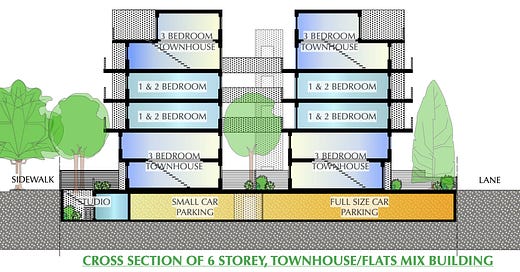Missing Middle Housing Missing no more
City Conversation #85: A retired architect’s brilliant proposal for affordable missing middle housing integrated with neighbourhoods, at high-rise density but no more than six storeys
October 5th 2022—a proposal that works for Vancouver
Two thirds of these homes are for families—concept and diagram by William McCreery, retired architect
“Bill, this is brilliant! And it fits Vancouver’s housing needs like a glove!” I was over the moon excited as I examined his concept design for affordable missing middle housing in Vancouver.
William McCreery is a retired architect well known for innovative housing solutions designed over decades of practice in many west coast communities. No stranger to housing ideas, Bill has been thinking for some time about alternatives to the we need high-rise towers to get housing density and affordability narrative that underpins the Broadway Plan and Vancouver Plan. But unlike so many talkers, he has actually designed a solution tailor made for Vancouver’s challenges and lot sizes.
It’s easy to plunk a high-rise point tower down on a city block—it doesn’t much matter if the block is in Vancouver, Toronto, Montreal, even Seattle, Dallas or New York. A high-rise block is the cheapest solution to design (not to build), can be designed by most any architect to go most anywhere and generally makes the most profit for its developer. All you have to do is ignore a city’s existing history and zoning by upzoning a single piece of property or land assembly—not to mention ignoring climate and energy issues, which high-rise exacerbates rather than solves. Studies by many experts, including at the City of Vancouver and BC Hydro, confirm again and again that high-rises use the most GHG energy to build and to operate. Period.
Vancouver’s Building Bylaw has for some time allowed up to six story construction all in conventional wood (that’s 2x4 and 2x6 studs with 2x10 floor joists, plywood sheathing, etc.). This will always be 25-40% cheaper to build than concrete high-rise—and construction just gets cheaper per square foot as height is reduced. More about that later.
“My challenges,” commented Bill, “include how to get a majority of two and three bedroom homes on a given development site. Since the Broadway Plan allows high-rise on an assembly of as few as three, 33 foot lots (99 feet altogether), I thought that was what I had to address to start.”
I nodded, interjecting with my enthusiasm. “What blows me away about your design are several things. Firstly, the density! The Mayor’s Making Home initiative, although never proven out, wanted to allow six homes on a single 33 foot lot versus the three or four already permitted in so-called single family areas—your design allows more than double that—39 homes in a space where his plan contemplated 18. I guess that’s what comes when you start with design rather than vague promises.”
He smiled at the thought, continued. “It was actually that Making Home scheme that got me to roll my sleeves up, knowing we could do better. The biggest challenges were to get density, but get it for families, while not upsetting neighbours by, for example, eliminating all the parking. This solution provides for all the needed parking—if parking requirements reduce over time, as we hope they will, we can simply create more housing on a property than shown here.”
I interjected again. “What also blows me away is the density achievable in just six storeys.”
“Yes,” he answered. “At six storeys we can get a density of FSR 3.0, which is more than the existing high-rise zones in places like Kits and Kerrisdale and more than the density sought by developments such as the Jericho Lands. I felt it was essential to making this real that we achieve high-rise densities in no more than more affordable six storey construction.”
He continued. “But what I’m proudest of is that two thirds of the homes in this scheme are family-sized—six two-bedroom apartments plus 20 three bedroom townhouses out of a total of 39 homes.”
I let that sink in for a moment, continued looking at the multi-block section on his drawing. “What I’m seeing is six storeys at the left terracing down to just two at the right—what’s that all about?”
Terracing from 6 storeys with shops at left down to two storey residential within a 7-minute walking radius—concept and diagram by William McCreery, retired architect
“I was also struggling with the proposal by some political parties that anybody should be able to build up to six storeys anywhere in the city. There are so many reasons that’s wrong, but my main concern is that we could end up with mid-rise buildings helter skelter all over the city, some near transit and shops (good), some in the middle of nowhere in terms of shops and services (bad)—kinda like the scatter gun that the Broadway Plan and Vancouver Plan propose, although they are worse, with mostly high-rises.”
“I’ve also been worrying about a completely random, unplanned city environment as proposed by the Broadway Plan and some political parties,” I said. “The argument is made that the corner store and apartments above is great—and I agree, except there are just a few of those and when they’re not well located the stores and neighbourhood suffer.”
He raised his palm to me to politely interrupt.
“This concern gave rise to what I call the 7-minute neighbourhood.” He showed me his diagram:
Seven minute walkable neighbourhood—concept and diagram by William McCreery, retired architect
“The city already has a network of transit stops, shopping streets, etc. And those need some added density to support them—just not the massive density proposed by the Broadway and Vancouver Plans. Unlike the city’s planners, I’ve measured what a 7-minute walk is from shops and services near a transit stop—in this case just a pair of bus stops. The section I drew terraces down from around the service/transit hub into the surrounding neighbourhood.”
“So what are the numbers?” I asked, although I had a suspicion I already knew.
“Those are the building heights in storeys that I recommended for this scenario—they would undoubtedly change a bit depending upon the particulars of each transport/service node.” I nodded agreement. He continued. “For this example, I count 7,400 people within a 7-minute walk to the transit stops.”
I did some mental math, gasped. “I’ve just finished doing some door-to-door canvassing for the civic election. That dotted 7-minute walking radius has about 400 homes in it—more, of course, if there’s already multiple residential development along the arterials—the light yellow streets.”
“But even if every lot in that radius had three or four rental and owned homes in it, as already permitted by so-called single family zoning, and allowing the city-wide average of 2.2 persons per home, then the 7,400 residents in your 7-minute neighbourhood is at least double what’s currently permitted!” He nodded agreement. I shook his hand.
“Bill, thank you so much for this work. It’s logical to place folks around transit and services. It’s logical to reduce the density as you move away from these concentrations. It’s logical for Vancouver—fine grained, transitioning mid-rise to low-rise, wood frame, climate conscious, logically planned without destroying neighbourhoods!”
The Time for Action is NOW
Please let me know what pre-election activities are happening in your neighbourhood—I will try to order my neighbourhood-based analyses to have maximum impact.
TEAM for a Livable Vancouver is the only political party pledged to set aside the Vancouver Plan and the related Broadway Plan and bring back neighbourhood-based planning, with the kind of affordable missing middle housing planned to integrate with the city’s neighbourhoods, as illustrated in this Conversation. Vancouver’s civic election is October 15th of this year. Lots more damage will be done to our city unless TEAM elects the next Mayor and a majority (6 of 10) City Councillors—less than 6 and not much will change for the better. A majority TEAM Park Board (4 of 7) will ensure our open spaces are integrated with the city rather than ignoring them. And our voice on the School Board will help bring schools into sync with parks, open spaces and neighbourhood development.
To best ensure the election of TEAM candidates, consider voting for them as a slate and for no other candidates—each vote for another party’s candidates, or independents, for Council, Park Board and School Board lessens the possibility of a TEAM-led city.
If you are concerned that the City Conversations you’ve been reading are examples of what’s wrong with our city and want to bring back Vancouver’s livability, join TEAM and work with us to restore Vancouver as a place we can all afford to call home.
And please let me know what other subjects you are passionate about so we can have that conversation before election day, October 15th.
Today’s question: Do you prefer Bill’s terraced 7-minute neighbourhood approach? Why or why not?
I read and respond to all comments made below. If you enjoyed this post, consider becoming a free subscriber to City Conversations at
Brian Palmquist is a Vancouver-based architect, building envelope and building code consultant and LEED Accredited Professional (the first green building system). He is semi-retired for the moment, still teaching and writing, so not beholden to any client or city hall. These conversations mix real discussion with research and observations based on a 40+ year career including the planning, design and construction of almost every type and scale of project. He is the author of the Amazon best seller “An Architect’s Guide to Construction.” He and Bill McCreery are also members of team for a livable Vancouver, a new political party dedicated to restoring a livable Vancouver starting with the 2022 civic election. City Conversations are generally congruent with TEAM policy, so if you like the ideas that I’m writing about, please consider joining TEAM.








This is well thought out and brilliantly executed. Now we need the political turnover to achieve this. Bravo Brian for your hard work in coming up with a livable solution
Well, if you were designing a neighbourhood from scratch, this plan seems amazing and great, but people already live in and love the neighbourhoods that are super-near to amenities. We live in a beautifully-maintained 1910 house with a really nice affordable suite in it in what would be deemed a 6-storey area. Will you propose to tear our house down? People LIVE in these areas!!